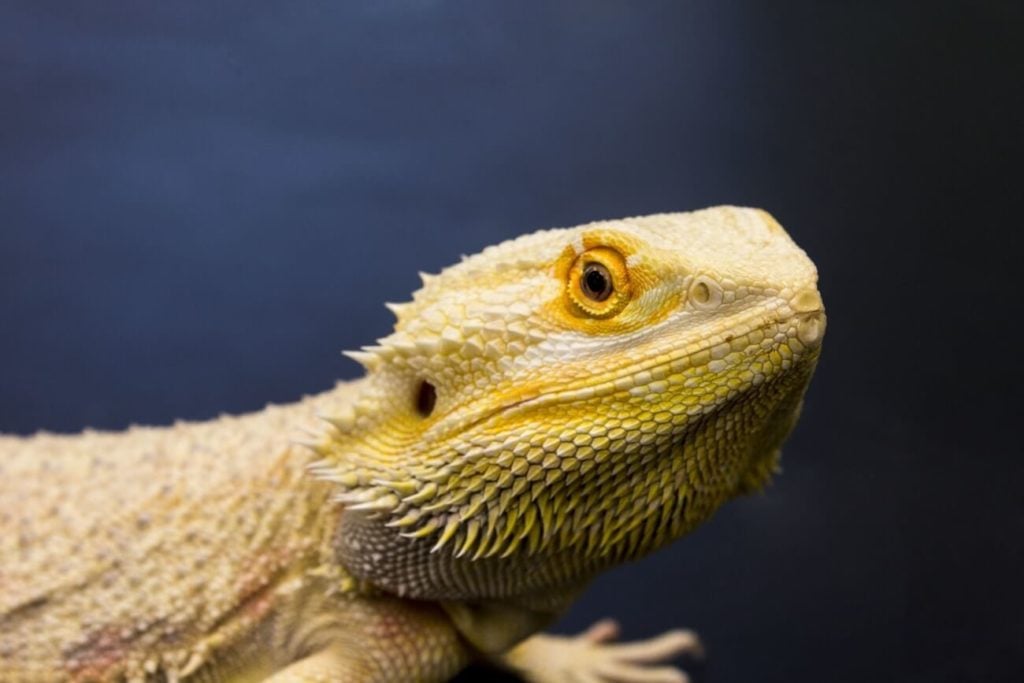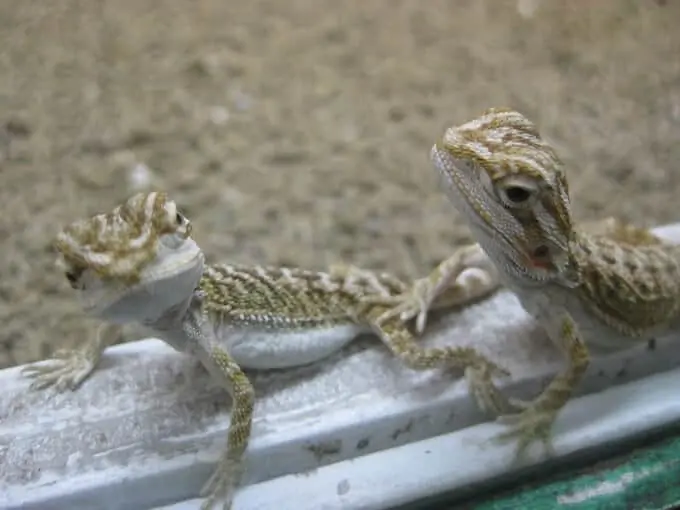Does Bearded Dragons Get Black Beards as They Age
Knowing how big bearded dragons get is an important step to take if you're considering getting one as a pet. Knowing their potential size will give you an idea of what you're getting into, and what conditions you'll have to provide.
But many future owners don't have any clue how large bearded dragons get, or what factors influence their size. Understanding what impacts their size makes it significantly easier to provide better care.
This guide will cover everything you need to know about bearded dragon size. By the time you're done reading it, you'll be ready to go!
Table of Contents
- How Big Do Bearded Dragons Get When Fully Grown?
- How Big Should They Be At Certain Ages?
- The Max Size Of Each Common Species
- Pogona Vitticeps
- Pogona Barbata
- Pogona Minor Mitchelli
- Pogona Minor
- Pogona Nullabor
- Pogona Minor Minima
- Pogona Henrylasoni
- Pogona Microlepidota
- Average Bearded Dragon Size At 1 Year Old
- How Does Gender Influence Their Size?
- Possible Causes For Slow Growth
- 1. Not Proper UVB Lighting
- 2. An Insufficient Diet
- 3. Early Brumation
- 4. Disease
- Wrapping Up
How Big Do Bearded Dragons Get When Fully Grown?
In order to properly care for your bearded dragon, you first need to estimate how big they get when fully grown. This is important because it will help you pick the best enclosure and determine a feeding plan.
These reptiles grow quickly for the first 3 months of life. Afterward, bearded dragons grow roughly another 1 to 2 inches each month for the rest of the year. Later, these reptiles can still grow another 1 to 2 inches during its entire second year of life.

Once they're done growing, bearded dragons can be anywhere from 12 to 24 inches long when fully grown (this measurement includes the tail). This is very manageable and makes them a good pet no matter how big your home is.
Expert Tip: Typically, a bearded dragon is considered to be fully grown once they've reached 11 to 12 months in age. However, some are not considered an adult until up to 18 months.
As you can probably tell, there isn't a perfect rule to predict exactly how big your bearded dragon can get.
This is because there are a number of factors that need to be considered related to a bearded dragon's growth processes. Some will reach their maximum size early at 8 to 10 months, and others will not reach their maximum growth size until later during its second year of life.
How Big Should They Be At Certain Ages?
Along with knowing the species of your new bearded dragon, it can be helpful to have a bearded dragon growth chart handy.
The growth chart below gives a high-level look of roughly how big your bearded dragon should be at various points throughout their first year.
| Age | Size |
|---|---|
| 0-1 months | 3-4 inches |
| 2 months | 5-9 inches |
| 3 months | 8-11 inches |
| 4 months | 9-12 inches |
| 5 months | 11-16 inches |
| 6 months | 11-18 inches |
| 8 months | 13-20 inches |
| 12 months | 16-24 inches |
Expert Tip: Remember to measure them from head to tail tip for an accurate length.
The Max Size Of Each Common Species
There are a number of species of bearded dragons, and each species has a different max size and growth rate.
Below we go into the differences in size and growth for each of the common species to help owners determine how big their bearded dragon will get.
Pogona Vitticeps
This central bearded dragon is considered the most popular and most common. These larger reptiles are naturally found in desert areas, forests, and drier bush environments.
Most owners of a Pogona Vitticeps report that this species is typically gentle in nature and loves to climb. As a general rule, these lizards stay awake during the daytime.
This bearded dragon can grow up to 24 inches in length when fully grown.
Pogona Barbata
This is also one of the larger bearded dragon species, and when grown can reach 24 inches long.
The Pogona barbata is also known as an Eastern Bearded Dragon or may be called a Coastal Bearded Dragon. Prospective bearded dragon owners should be aware that this species is known to be territorial when around others. Owners can also expect these lizards to be awake during daylight hours.
Like most other species, the Pogona barbata enjoys climbing and wandering around exploring their environment. In the wild, these lizards are found in wooded areas known to be dry.
Pogona Minor Mitchelli
These are commonly called the Mitchelli Bearded Dragon and can grow up to 18 inches in length.
In general, this species is quite rare. Expect to find these lizards in desert regions and in semi-tropical wooded areas.
Pogona Minor
The Pogona minor is commonly called the Dwarf Bearded Dragon although it can grow up to 14 to 18 inches during their lifetime. This is another lizard that is considered a rare species, and these reptiles prefer rocky areas as well as shaded wooded regions.
Pogona Nullabor
The Nullabor Bearded Dragon is another rare species, and it can grow to be up to 14 inches long when fully-grown. These mid-sized lizards make their home in drier brush environments that are mostly flat.
Pogona Minor Minima
Another name for this type is the Pogona minor minima or simply the Western Bearded Dragon.
These hard-to-find lizards like dry and woodsy environments and may only grow up to 12 inches in length.
Pogona Henrylasoni
These smaller dragons are commonly called the Lawsons Bearded Dragon. Owners can expect these lizards to remain on the small side only reaching 12 inches or less.
In their native environments, these reptiles prefer arid desert regions or drier rocky settings where they spend their days happily climbing.
Pogona Microlepidota
The common name for the Pogona microlepidota is the Drysdale River Bearded Dragon. This lizard is quite rare, and tend to live in woodland areas or in coastal geographical regions.
This beardie is the smallest growing only up to 4 to 6 inches during their lifetime!
Average Bearded Dragon Size At 1 Year Old
As we mentioned before, the most commonly kept species of beardie is the Pogona vitticeps. These popular bearded dragons should be around 15 to 18 inches in length at approximately 1 year of age.

Some will be a bit smaller, and others could grow another few inches over its second year. These beardies are generally considered adults between the 12 and 18-month mark.
How Does Gender Influence Their Size?
Like most creatures, the gender of your bearded dragon will influence its overall size. For example, a commonly kept beardie will end up being around 16 to 24 inches long when fully-grown.
Males are typically longer, so expect their length to be on the higher side at 21 to 24 inches. Females should measure somewhat smaller at 16 to 19 inches.
However, even though a male bearded dragon is usually longer, the body of a female is a bit broader. The female's tail is also somewhat slimmer than their male counterparts. A male beardie's head is generally bigger as well.
Possible Causes For Slow Growth
As already stated, the above measurements and growth ranges will vary somewhat between species.
However, there are also a number of other factors that will influence the potential size of your bearded dragon (or the growth-rate). Most of them can be influenced by the quality of care you provide, so it's important to understand them thoroughly.
1. Not Proper UVB Lighting
To remain healthy, a bearded dragon needs the proper amount and intensity of UVA and UVB lighting. There are special UVB light bulbs that are designed to be placed in your beardie's tank.
In order to stay healthy, bearded dragons need a basking bulb and spot to soak up these critical UVB rays. The size of a bearded dragon can be stunted or slowed down dramatically if they do not get the right amount of UVB light during their normal day to night rhythms.
The lack of UVB light can also lead to serious health concerns including weak or brittle bones. This is because not enough UVB light results in the bearded dragon becoming unable to properly absorb the calcium in their diets.
They may become lethargic for no apparent reason and might lose their appetite, further stunting their expected growth and size.
Expert Tip: These UVB bulbs need to be replaced roughly every 6 months. Make sure to keep track of this, because there's often no clear sign that the bulb isn't working anymore!
2. An Insufficient Diet
Your bearded dragon will need the right food and diet containing plenty of protein-rich insects during their first three months (also considered the baby phase). During this time, feed your pet three times per day to assist their growth.
These insects should be preferably bought from a reputable breeder or supply retailer to avoid dangerous insecticides and other toxins that may be present in freshly caught bugs.
Additionally, bearded dragons will need fresh or thawed frozen veggies to help them reach their maximum size. Gradually decrease the number of insects in favor of more vegetables as your beardie grows.
3. Early Brumation
While in their natural environment, bearded dragons regularly go into brumation as winter approaches. This brumation period is similar to the hibernation phase we're see in some mammals.
Bearded dragons will slow down, sleep more, and reduce the amount of food they're eating. This is designed to help them conserve energy and make it through the tough winter months.
It's quite common for bearded dragons to go through brumation in captivity, and it's usually not anything to be concerned about. However, if this happens when they're too young there can be problems.
These early years are crucial for your bearded dragon to grow and reach their full size. If they spend this time resting and avoiding food, that can obviously set them back when it comes to growth.
Expert TIp: If this happens we recommend that you read our guide (linked above) to better understand the process. Then contact your vet to come up with a plan.
4. Disease
If your bearded dragon gets seriously sick, it might impact how big they end up getting (assuming this happens while they're still growing).
There are a number of different ways this can happen. A decreased appetite might lead to insufficient food consumption, or a parasite could be stealing vital nutrients that your beardie needs to grow.
Fortunately, there are a number of things you can do to prevent this from happening. They're all fundamentals of good care, but are always worth repeating:
- Keep their enclosure clean
- Don't feed them insects caught in the wild
- Make sure the water in their cage is clean
- Give them the proper light
- Maintain recommended humidity levels
If you stay on top of these the chance of your bearded dragon getting sick decreases significantly. This will help them grow to their maximum potential size!
Wrapping Up
As you can see, there are a number of factors that can influence how big bearded dragons get. Just like any animal, their growth can be hindered if they're kept in suboptimal conditions.
We hope this guide not only teaches you about the size of bearded dragons in general, but how to provide them with great care.
If you still have questions we're more than happy to help you out. Just reach out to us directly and we'll respond as soon as we can!
Does Bearded Dragons Get Black Beards as They Age
Source: https://www.reptiledirect.com/how-big-do-bearded-dragons-get/